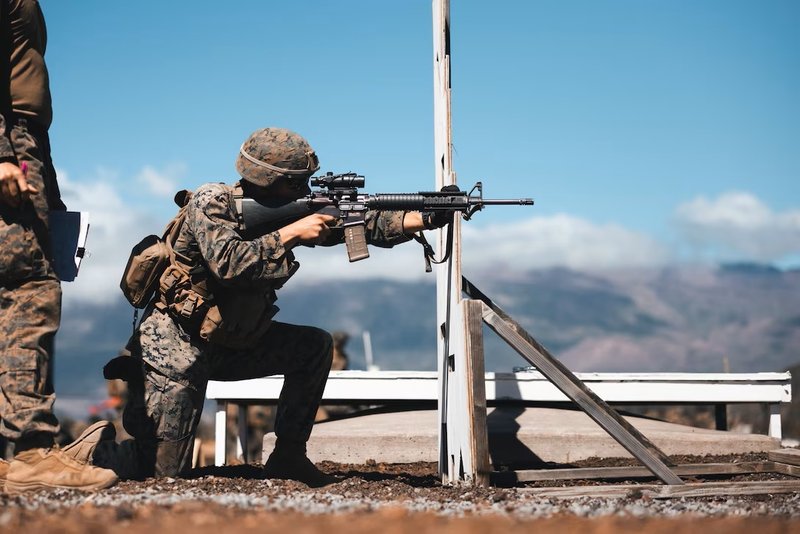Why rethinking training is vital for the USMC’s new force design
As the USMC reshapes its operational capabilities as part of the Force Design 2030 initiative, it has been addressing its training and education provision to support the needs of the future force.
To support this effort, back in January 2023 it produced a major report, Training and Education 2030, which addressed the future needs of the corps... Continues below
Newsletter Sponsor:

Above: The current USMC training culture tends towards choosing between live and virtual options. That approach needs to change to meet Force Design 2030 goals. (Photo: USMC)
Speaking at the 2023 I/ITSEC 23 event in Orlando, Lt Gen Kevin Iiams, Commanding General, USMC Training and Education Command (TECOM), said that ‘we have got to move to holistic training… [and] we need common data standards as we move to the future so that all our systems can play synonymously across the board in the training environment’.
He emphasised the need for USMC training to be focused on lethality and rigour, with measurable, repeatable standards. The T&E 2030 report laid down 37 actions and 16 areas that required further investigation, with three large projects, Triumph, Trident and Tripoli emerging as a result.
According to TECOM documentation Project Triumph ‘aims to improve the learning experience of the individual Marine by transitioning our learning continuum from instructor-based lecturing, to active, student-centred learning. The goal is to provide a mature, cognitively agile Marine, who is both a problem solver and decision maker, but most importantly, a manoeuvreist, and to do it faster and sooner in a Marine’s career than we do now.’

Providing mission-critical training and equipment, this elevated level of innovation can only be provided by the best in the industry. Visit FlightSafety.com.
Project Trident meanwhile ‘aims to enable the combat readiness of warfighting organisations by providing individual and unit level training to build and close kill webs in a contested maritime environment, at all echelons, and utilising assets and capabilities across all domains’.
Project Tripoli is the most extensive and ambitious of the three. It is ‘a comprehensive initiative to modernise the Marine Corps' training environment. Its goal is to eliminate gaps between experimentation efforts, the training continuum, and real-world mission rehearsals and operations’. The aim is to provide the Fleet Marine Force with an on-demand, multi-domain LVC training environment (LVC-TE) that will align with the operating concepts of Force Design 2030.
According to the T&E 2030 report ‘LVC-TE will serve as the cornerstone of how the Marine Corps builds combat readiness during this critical time of transformation… The primary objective is to increase combat readiness at every echelon of command, while also allowing for experimentation with emerging concepts and technologies’.
Other articles in this newsletter:
New rules – how the US Marine Corps is taking wargaming to the next level
IDF leverages new target technology for small arms training
The capability should be scalable, supporting individual training at entry level, but also applicable to collective training progressively right up to the Marine Expeditionary Force commander within a major exercise. LVC-TE should allow the USMC to transform its training culture from making binary choices between live or synthetic to a ‘progressive model incorporating live and synthetic training, simultaneously’.

Above: Project Tripoli aims to pull all domains and live, virtual and constructive elements together into a single training environment. (Image: USMC)
The project consists of 16 components, including: the new Saab-supplied force-on-force tactical engagement simulation system, the Marine Corps Tactical Instrumentation Systems (MCTIS), which is about to enter service; simulators for other incoming systems; range instrumentation; refreshment of the Small Unit Tactical Training System (SUTTS) family; and new database, network and common platform services.
For his part, Iiams described LVC-TE as ‘a multi-domain training range for the future. We’re putting all our capabilities in one training environment, so we can do the sets and reps we need before we go into combat operations.
‘We need new simulators for the new equipment that is coming in, like NMESIS [Navy Marine Expeditionary Ship Interdiction System], the ACV [Amphibious Combat Vehicle], and OPF [Organic Precision Fires]. We need standardised adversary models and more artificial intelligence in our constructive simulations.’
He said the aim was to create a ‘multi-classification enclave so we can train everybody in high fidelity’. This is clearly an ambitious enterprise with many moving parts. Bringing it to fruition poses challenges for industry and the corps alike, and many will be keenly observing its progress.
Don't want to miss out on future Decisive Edge content? Make sure you are signed up to our email newsletters.











